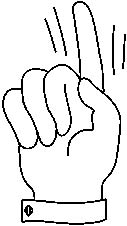Dear Etiquetteer: I enjoy wearing white tie to the opera, despite the snide comments from the sartorially challenged. My problem is finding the appropriate tie. I was taught that since white tie is highly formal, the tie should be restrained and have very little flare. My old tie is nearly worn out, and the only white bows available are practically the size and shape of Luna moths. Am I overly restrictive in what I think look appropriate for white tie (and on me for that matter) or is this another failure of the American clothing industry? There is no rush for this question; the opera company has gone on hiatus due to "the current economic situation."
And, by the way, what is appropriate (non-funeral) attire for those mourning the loss of a close friend? Is there such a thing?
Dear Tied:
Etiquetteer thinks you have not been searching broadly on-line for a new white tie. If you visit Beau Ties Ltd. and order your choice of bow ties in "Very Slim Line," your need for an absence of flair will be met with Perfect Propriety.
Etiquetteer also enjoys white tie. But in an age where only ambassadors, conductors, magicians, and community theatre choruses wear it, Etiquetteer must regretfully advise caution. If you are the only gentleman in the audience so attired, you may not be making the impression you wish. Parvenus, more than ever, are to be shunned. And you would appear even more so wearing white tie in the balconies. White tie belongs without question in the orchestra or the boxes, but not above them. "Dress Circle," alas, is a distinction in name only.
Emily Post, may she rest in peace, used to refer to a "brilliant opera night" when the ruling matrons decided among themselves that extra jewelry would be worn, usually if someone was giving a ball that night. This reminds Etiquetteer, of course, of Regina Beaufort in The Age of Innocence, Edith Wharton's greatest novel, departing at some point before the end of the third act, thereby signalling the start of her ball after the performance.
As for mourning clothes outside a funeral, the custom has all but disappeared. The original purpose of mourning clothes was to deflect unwelcome attention, but Etiquetteer has to wonder if your purpose is really to show respect for the dead. Gentlemen used to wear a black armband over their right coatsleeve during mourning, which would now be considered ostentatious. Just wearing black won't do, since it's still considered so hip and edgy by so many. (Ladies could also be mistaken for bridesmaids, to Etiquetteer's continued chagrin.) And most people today are too oblivious to color distinctions even to recognize half-mourning, which is the absence of blue, red, yellow, and green.
The only thing Etiquetteer can recommend that would be universally recognized as a gesture of mourning is the memorial button, often seen with a picture of the deceased, handed out at so many funerals. To wear such a button on your lapel ought to let even the most thick-headed lout know that you're mourning someone who died recently. And by recently, Etiquetteer means "within the last month." For good or ill, usually the former, it's no longer customary to wear mourning after the funeral.
Dear Etiquetteer:
What is your opinion about wearing a bow tie with a sweater?
Dear Sweating:
Would it surprise you to learn that Etiquetteer doesn't really have an opinion? Etiquetteer can't really find anything wrong with wearing a bow tie with a sweater, nor a requirement that one must. So by all means, tie one on! As a guideline, not a rule, Etiquetteer would suggest pairing bow ties with crew neck sweaters and neckties with V-neck sweaters.
Etiquetteer has a new address for all your manners queries, queries_at_etiquetteer_dot_com.






